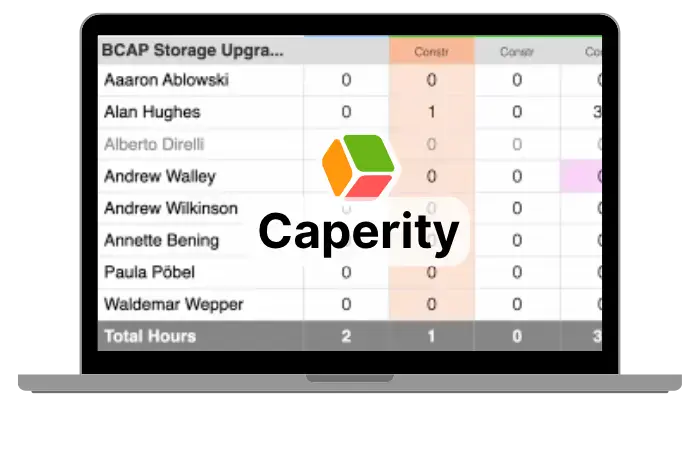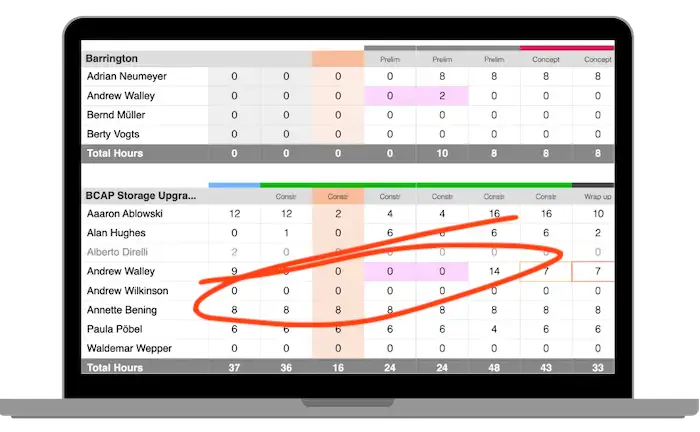Creating a project budget may be overwhelmin, if you’ve never done it before.
In this article I’ll show you the process. Afterwards you’ll be able to set up a solid budget on your own.
Let’s get started.
The first question I’ll answer is:
What goes into a project budget?
Labor
- labor of internal resources
- labor of external resources
Goods and services
- materials used for production
- services purchased
- consulting or legal fees
- insurance
Travel
- airfare
- car rental
- accommodation
- food
- visa fees and services charges
Investments
- machinery
- computer hardware
- licenses
- intellectual property
The major part of every project budget will be labor cost.
Labor cost can be broken down into:
- cost of internal resources
- cost of external resources
First you need to estimate the effort of every person involved in the project, both for internal and external resources. What you need to prepare is a spreadsheet with the number of days per month each resource works on the project. If you don’t have an appropriate template, I recommend you get my project budget template.
So, how do you figure out the effort for each member of your team? You talk to each person and ask: “What will be your effort for completing X?” Your team members usually know best how much time they need (read also: how to set deadlines in a project).
A word of warning: Be skeptical about estimations. Some people tend to overestimate while others underestimate the amount of time required. I like to challenge people when my gut tells me the numbers are unrealistic.
Asking people for an estimate doesn’t always work. Some tasks are too complex to make a quick estimate. In those cases you need to break those tasks into pieces and estimate each piece separately.
Here’s another estimation method which works well for repetitive tasks: Assume you want to manufacture 1000 cars. Instead of trying to estimate total effort in one go, you estimate the time required to produce a single car. Then you multiply that number by 1000 and you have the total time required for the entire production cycle.
Recommended article: Read my guide on estimating effort hours in projects.
From labor effort to labor cost: how to make the calculation
Now you have estimated labor effort. How do you get from effort (measured in days) to currency values? You have to put a price tag behind each day and make a simple multiplication:
labor cost = # effort in days x $ cost per day
Now you probably ask yourself: “How do I know what to charge for each day?” That’s a question either HR or your internal accounting team can answer. Companies usually have tables with cost rates for their staff, broken down by department.
For external resources like freelance developers or consultants, you usually have a fee agreement which states the rate charged per hour.
Cost of goods and services
Next, let’s have a look at project-related expenses for material and services.
Does your project require any goods or particular services to be able to reach the target? Then you need to include those in the budget plan.
Examples for goods:
- material required for prototyping (e.g. in engineering)
- low-value items (e.g. office supplies)
Examples for services:
- consulting
- insurance
- rental fees
- legal advice
Travel expenses: They can eat up your budget quickly
Travel cost can easily amount to hundred thousand dollars or more, if the project involves a lot of traveling to faraway countries. Therefore, you must do a good job in estimating the scope and frequency of business trips.
Travel expenses are:
- airfare
- car rental
- accommodation
- food and drinks
- visa fees
- services charges payable to travel agencies
Estimate the number of business trips and set a limit of how many people are going to be on the trip. This makes it easier to forecast travel expenses. Remember also that business trips are no fun events. Only people who are absolutely required should be allowed to go on the trip.
Example: Let’s say you’re running a project at your Mexican subsidiary . Then you can estimate your travel requirements in the following fashion:
Trip #11: Initial scoping. 5 people who will stay for 1 week.
Trip #2: Business workshop. 12 people who will stay for 2 weeks.
Trip #3: Functional test: 12 people who will stay for 2 weeks.
Trip #4: GoLive: 10 people who will stay for 2 weeks
Figure out airfares to your destination as well as hotel rates, put everything into a spreadsheet and do the multiplication.
Also note that accommodation and flight fees can vary significantly depending on the season. Go to Google Flights or Priceline.com to check flight and hotel prices. Your calculation should thus not only consider current rates but expected rates at the time of travel.
Investments: are you getting machinery, computers, or anything of the like?
Investment goods – also called assets – are items a company uses for its production or provision of services. Think of expensive machinery, vehicles, but also computers and software.
Examples of investment goods:
- machinery
- vehicles
- software licenses
- computer hardware
Investment expenditures are handled slightly different in a project budget: the purchasing value isn’t recorded as a one-off expense but distributed over the lifetime of the asset.
Example: For the latest project, your company buys a new truck worth $400’000. The truck is purchased in May 2018 and it’s going to be used for 7 years. Now, we don’t record the $400’000 as an expense. Rather, we have to spread the amount over the truck’s total lifetime, which is 7 years or 84 months. The monthly expense is $400’000 / 84 = $4’762. That’s the number that must go into your budget.
Should your project budget include taxes?
No matter what your project is for, almost always some purchases have to be made. Think of materials or services that are going to be used in some form or another. You hire a consultant, you purchase physical items like screws or cables. It doesn’t matter. And companies have to pay taxes, most importantly VAT (value added tax). The question you have to answer is whether the project budget should show the cost with or without taxes.
In 99% of cases you should exclude tax. Why? Most companies are able to recover tax on goods purchased. Therefore the tax will not permanently reduce a company’s profit and thus shouldn’t be factored into the budget. In case a company is unable to recover taxes (for whatever reason) for a specific item, you should add the tax amount into your budget. Your accounting team can answer the question whether to include or exclude tax. Just ask.
Create the project budget overview
Finally let’s create the project budget. You take the cost that you’ve estimated in each of the categories and put them into a spreadsheet.
If you haven’t checked out my project budget template, I recommend you do it now. People have told me it has saved them hours when setting up new projects.
Read next: How to keep track of project costs
I have written an article on tracking project expenses, which I recommend if project cost management is new and scary to you. It’s actually not that complicated — you just need to learn the process.
Author
-
Hi, I’m Adrian, a Senior Project Manager and the Creator of Tactical Project Manager, where I teach a pragmatic approach to project management. Led large-scale IT and business projects for over 10 years. My goal is to enable you to lead any project with confidence.
View all posts

